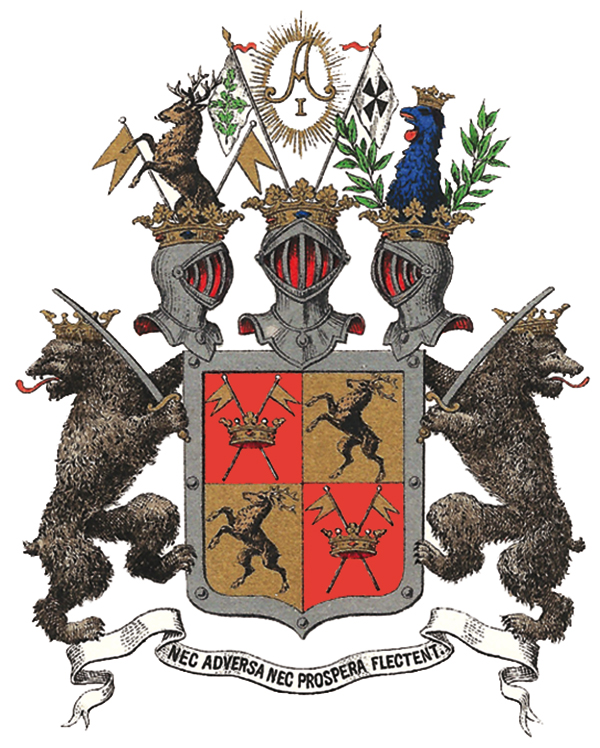Coats of arms
The Noble coat of arms
It seems obvious that Feodor Aminoff did not have a family heraldic coat of arms, as such was not a Russian custom. The coat of arms was designed in conjunction with a (Swedish) royal patent of nobility. Aspects of the coat of arms indicate that its precursor was baltic. There are other Baltic escutcheons where a quartered shield appears where two sectors are occupied by military emblems alone or crossed through a crown, and the other two sectors feature a rampant deer.
The heraldic description or blazon follows: A quartered shield. In the first and fourth quarters: red through a crown gold two halberds silver with gold cavalry standards. In the second and third quarters: gold a leaping hart in natural color. On the helm a wreath in red, gold, and silver, as a crest on the helm a half hart between two raised halberds. Leafwork in red, gold and silver.

The Baronial coat of arms
Traditionally, persons who were elevated to the comital estate set their noble arms as central and often surrounded them with four quarters. For Johan Fredrik Aminoff, who already had four quarters in his noble arms, such a solution would have led to a complicated and in smaller formats indistinguishable composition. He chose a significantly better solution by keeping the shield unchanged, and just distinguished it from the noble shield by surrounding it with a argent border with eight nail heads. On account of the limited heraldic understanding of the time, the official description incorrectly described the halberds as standards with black poles. On the shield rests a baronical crown between two helmets crowned with the same crown. The right helmet shows the noble crest’s helm-decoration unchanged, the left a crowned blue rooster head between two green twigs. Over the baronical crown floats Alexander I’s initials in gold surrounded by a halo of rays over crossed standards, the right with a crossed laurel branch and oak branch, the left with a black Maltese cross. The shield holders are two bears looking over their shoulders, each carrying a saber. They are borrowed from the coat of arms of Satakunta and indicate Johan Fredrik’s position as chief of the Björneborg regiment. A band from the shield carries the family’s motto: ”Nec adversa nec prospera flectent”, that is to say ”may neither success nor adversities have influence.”
In other words, Johan Fredrik only added a border with nail heads to his shield. Due to the superficial knowledge of heraldry during this time period, the lance flags were reproduced with black shafts. The heraldically correct decorations of the helmet is the ones from the noble coat of arms, but with black shafts. The new helmet decoration on the left also originates from the poor knowledge of heraldry of the time. Johan Fredrik’s mother was born into the family of Rotkirch, and the helmet decoration was taken from her family’s faulty version of coat of arms used at the time. At this point three crowned roosters were believed to be the sign of the coat of arms in question, but they were in fact crowned eagle heads. Placing the emperor’s act of grace, the monogram of Alexander I - which on the coat of arms can be discussed. The baronial rank was originally granted by King Gustav II Adolf of Sweden, not to mention the fact that it is not very heraldically correct to add free elements above the arms. The arms were not only supposed to be possible to reproduce visually, in principle the arms were supposed to actually be wearable as well. All the same, it was in fact Alexander I who granted the baronial rank in the present extent when creating the arms themselves. The supporters of the arms, the two bears originates from the coat of arms of the region of Satakunta and refers to Johan Fredrik’s position as the commander of the Regiment of Pori.
More information on the birth of the baronial and the comital family branches can be found here.
Click here to read more about Johan Fredrik.

The Comital coat of arms
When Johan Fredrik Aminoff received the comital rank in 1819, with inheritance limited by primogeniture he improved the baronial coat of arms (according to the blazoning approved by the emperor) by changing the crowns of the tournament helmets from baronial crowns to comital crowns. Moreover, he traded the baronial crown in the middle on top of the coat of arms for a open tournament helmet crowned with a comital crown. The monogram of Alexander I surrounded by a golden halo between two banners in silver, familiar from the baronial coat of arms, was chosen as the helmet’s crest.

